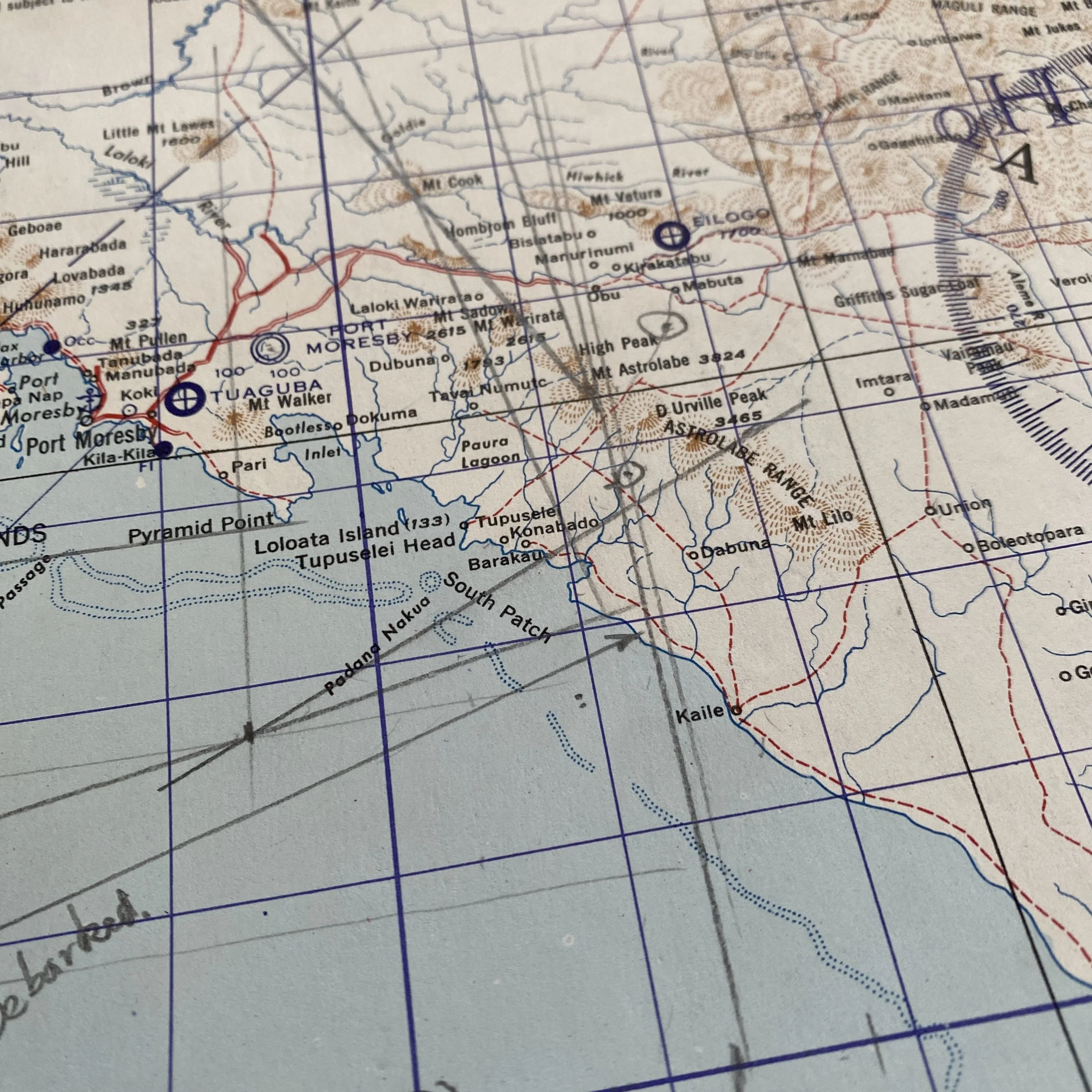RARE! WWII 1943 "Battle of Port Moresby" New Guinea Heavily Marked U.S. Combat Operations Map*


















RARE! WWII 1943 "Battle of Port Moresby" New Guinea Heavily Marked U.S. Combat Operations Map*
Comes with hand-signed C.O.A.
This rare and museum-grade WWII map was used by U.S. forces operating out of Port Moresby (New Guinea) during World War II. The Battle of Port Moresby was an aerial battle fought between the Royal Australian Air Force (RAAF) and United States Army Air Force (USAAF) on one side and the Imperial Japanese Army and Imperial Japanese Navy on the other between 3 February 1942 and 17 August 1943 over Port Moresby, Papua. At the start, the defenders consisted only of Australian Army anti-aircraft batteries and machine-guns, but by late March had been strengthened by the arrival of Kittyhawk fighters from No. 75 Squadron RAAF. However, in just nine days they lost 11 aircraft and only the arrival of replacements enabled the unit to maintain ten serviceable machines.
Dated 1943, this map features many operational hand-annotations including markings off the port for “CRUISER ESCORT” and other numerous navigation lines.
Port Moresby, the capital of Papua New Guinea, played a crucial role during World War II as a strategic outpost in the Pacific theater. The city's significance lay in its location, which served as a key point in the Allied efforts to halt the Japanese advance in the region. The use of Port Moresby became a focal point in the broader context of the Pacific War, influencing the outcome of battles and shaping the course of the conflict.
In the early stages of World War II, the Japanese sought to expand their empire by securing control over the Pacific islands. Port Moresby, with its strategic position in the southwestern Pacific, emerged as a critical target for the Japanese forces. Its capture would have provided them with a base from which they could threaten Australia and isolate the Allies in the Pacific. Recognizing the strategic importance of Port Moresby, the Allied forces, primarily composed of Australian and American troops, endeavored to defend the city against the impending Japanese invasion.
One of the most notable engagements in the region was the Battle of the Coral Sea in May 1942. This naval battle, fought between the Allies and the Japanese, aimed to prevent the Japanese from capturing Port Moresby. The significance of the Battle of the Coral Sea lies in its status as the first naval engagement in history where opposing fleets never came within sight of each other. Instead, aircraft from aircraft carriers played a pivotal role in determining the outcome. The Allies successfully thwarted the Japanese advance, preventing the capture of Port Moresby and safeguarding a crucial strategic position.
Following the Battle of the Coral Sea, Port Moresby became a vital base for Allied operations in the Pacific. The city served as a launching point for air raids and offensive actions against Japanese-held territories. The Allies utilized Port Moresby's airfields to conduct bombing raids on Japanese positions, disrupting their supply lines and weakening their overall war effort. The city's importance as a forward operating base allowed the Allies to project power and maintain a presence in the region, ultimately contributing to the broader strategy of rolling back Japanese advances.
Port Moresby's significance extended beyond military operations to include logistical support and intelligence gathering. The Allies established a network of communication and supply lines through the city, enabling the coordination of operations across the Pacific. Additionally, the presence of Allied forces in Port Moresby facilitated intelligence gathering on Japanese movements and intentions, providing valuable information for strategic decision-making.
The challenges faced by both Allied and Japanese forces in the harsh and unforgiving terrain surrounding Port Moresby added another layer of complexity to the conflict. The mountainous and jungle-covered landscape presented logistical difficulties for both sides, impacting the movement of troops and supplies. The harsh conditions and tropical diseases posed additional threats to the well-being of soldiers, making the struggle for control over Port Moresby a test of endurance as well as military strategy.
In conclusion, the use of Port Moresby during World War II was pivotal in shaping the course of the Pacific War. The successful defense of the city in the Battle of the Coral Sea marked a turning point in the conflict, preventing the Japanese from gaining a foothold in the region. Subsequently, Port Moresby became a crucial base for Allied operations, facilitating air raids, logistical support, and intelligence gathering. The city's role in the Pacific theater exemplifies the strategic importance of certain geographical locations in determining the outcome of large-scale conflicts.